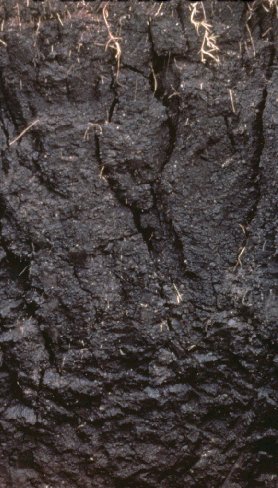
Surface of a Vertisol, showing cracks (southern Spain). Credit A. Jordán (http://personal.us.es/ajordan).
Vertisols are dark clayey soils that show cracks at least during some part of the year. Normally, Vertisols are found in depressions or plain areas under subhumid or semiarid climate, with a wet and a dry season. Although climax vegetation is savanna, grassland or woodland, Vertisols are very fertile, so that agricultural use is very common. However, the process of swelling/shrinking makes Vertisols very difficult to till.
Temporal changes in physical attributes of these soils require accurate timing of agricultural practices for efficient use. Tillage is extremely difficult when soil is wet as it is sticky and adheres to tools. Also, when dry, it becomes extremely hard. So, heavy tillage must be restricted to the short transition period between the wet and dry seasons, even with high-input technologies. Adequate management allows high productivities.
Vertisols cover 335 million hectares world-wide, mainly in the semiarid Tropics, but also in other areas in Australia, America (southwestern USA, Uruguay, Paraguay and Argentina) and Europe (Spain), usually between parallels 50ºN and 45ºS. In addition to geomorphology, distribution of Vertisols is restricted to the conditions of formation of smectite (high temperature, rainfall sufficient to enable weathering but not so high that leaching of bases occurs, dry seasonal periods to allow crystallization of clay minerals and impeded drainage).

World distribution of Vertisols. Credit: UN Cartographic Section. Click on the image to see the original picture at Wikimedia Commons.
The properties of Vertisols are a consequence of the high proportion of smectite in its composition. Smectite shows a peculiar crystal structure, since its basic unit is formed by layers of two sheets of silicon tetrahedra and one sheet of octahedra. However, while the interlayer space in other clays is very stable (about 10 angstroms, 10E-9 m), it may vary between 14 and 18 angstroms in smectite, because the bond between them is done by very weak forces (Van der Waals forces). This makes easy the ingress of water into the interlayer space. Thus, in climates where there is a seasonal distribution of rainfall, accumulated water in the interlayer space of the smectite is lost during the dry season, the space is reduced and, therefore, soil aggregates contract. Similarly, the entry of water into the interlayer space in the wet season makes the sheets to separate the crystal structure .
The contraction of the aggregates during the dry season causes the appearance of cracks in the soil surface that sometimes can reach up to several meters deep and several inches wide. In the rainy season, the water inlet in the interlayer space of the smectite produces expansion and, therefore, the aggregates swell closing cracks. Continuous movements of expansion/contraction caused by clay lead to a uniform distribution of oriented clay particles in the surface of aggregates, which can form even reflective surfaces known as slickensides, a characteristic phenomenon of Vertisols .
The repeated cycles of aggregate shrinkage and swelling, thereby opening and closing of cracks, causes a sort of self- mulching. In the long-term, soil material falling in cracks during each dry season produces the mixture of the material and the upper horizon can be very deep due to the internal continuous turnover. The process of opening and closing of cracks produce a characteristic relief , known as gilgai. In agricultural soils, gilgai may be difficult to observe due to tillage .

Gilgai pattern on Vertisol. Credit: NRCS. Click on the image to see the original picture at theUniversity of Idaho site.
Know more
Bandyopadhyay, K.K.,Mohanty, M., Painuli, D.K., Misra, A.K., Hati, K.M., Mandal, K.G., Ghosh, P.K., Chaudhary, R.S., Acharya, C.L. 2003. Influence of tillage practices and nutrient management on crack parameters in a Vertisol of central India. Soil and Tillage Research 71, 133-142. DOI: 10.1016/S0167-1987(03)00043-6.
Battikhi, A.M., Suleiman, A.A. 1999. Temporal variation of infiltration rate in a Vertisol under lentil–wheat rotation. Journal of Agronomy and Crop Science 183, 67-70. DOI: 10.1046/j.1439-037x.1999.00317.x
Boivin, P. 2007. Anisotropy, cracking, and shrinkage of vertisol samples. Experimental study and shrinkage modeling. Geoderma 138, 25-38. DOI: 10.1016/j.geoderma.2006.10.009.
Dinka, T.M., Morgan, C.L.S., McInnes, K.J., Kishné, A. Sz., Harmel, R.D. 2013. Shrink–swell behavior of soil across a Vertisol catena. Journal of Hydrology 476, 352-359. DOI: 10.1016/j.jhydrol.2012.11.002
Driessen, P., Deckers, J. 2001. Lecture notes on the major soils of the world. World Soil Resources Report 94. Food and Agriculture Organization of the United Nations. Rome.
McGarry, D. 1989. The effect of wet cultivation on the structure and fabric of a Vertisol. Journal of Soil Science 40, 199-287. DOI: 10.1111/j.1365-2389.1989.tb01266.x
Millán, H., Tarquís, A.M., Pérez, L.D., Mato, J., González-Posada, M. 2012. Spatial variability patterns of some Vertisol properties at a field scale using standardized data. Soil and Tillage Research 120, 76-84. DOI: 10.1016/j.still.2011.11.003.
Mohanty, M., Painuli, D.K., Misra, A.K., Ghosh, P.K. 2007. Soil quality effects of tillage and residue under rice–wheat cropping on a Vertisol in India. Soil and Tillage Research 92, 243-250. DOI: 10.1016/j.still.2006.03.005.
Pal, D.K., Wani, S.P., Sahrawat, K.L. 2012. Vertisols of tropical Indian environments: Pedology and edaphology. Geoderma 189–190, 28-49. DOI: 10.1016/j.geoderma.2012.04.021.
Recio Espejo, J.M., Gil Olmo, J., Medina Carnicer, M. 1988. Closed basins and Vertisol formation in the rincon lagoon (Andalusia, Spain). Catena 15, 407-416. DOI: 10.1016/0341-8162(88)90061-6.
This post was also published simultaneously in G-Soil.


